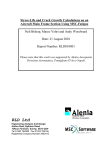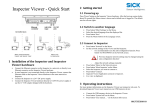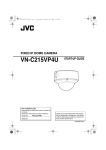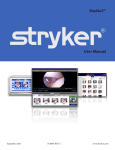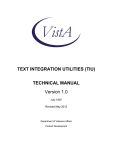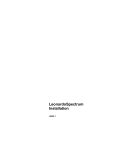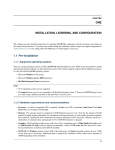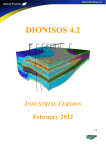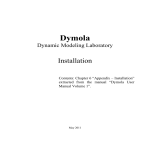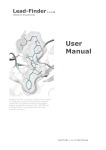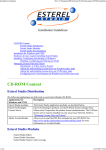Download Eagle Flex Plus Licensing Guide
Transcript
EAGLE FLEX LICENSING macrovision C RE AT I VE S O FT WA RE Eagle Flex Plus Licensing Guide “A resource guide to Eagle licensing for system administrators and developers” Revision Nr 1.8.1 en Page 1 September 2011 EAGLE FLEX LICENSING macrovision C RE AT I VE S O FT WA RE Revision Nr 1.8.1 en Page 2 September 2011 EAGLE FLEX LICENSING macrovision C RE AT I VE S O FT WA RE Contents 1 – Introduction to Eagle Licensing .............................................................................................. 6 Further Reading ....................................................................................................................... 8 2 - Flex Based Licensing System Overview ................................................................................... 9 2.1 License Server Components ............................................................................................. 10 2.2 Installation Sequence ....................................................................................................... 11 3 – Requesting a License for a Server ......................................................................................... 12 3.1 Generate a HostID............................................................................................................ 13 3.1.1 Using a Flex hardlock as HostID.................................................................................. 13 3.1.2 Using an Ethernet as HostID....................................................................................... 13 3.1.3 Generate a host ID using LMUTIL ............................................................................... 14 3.1.4 Generate a Host ID using LMTOOLS ........................................................................... 14 3.2 Generate a Unique Serial Number .................................................................................... 15 3.3 Completing the License Request....................................................................................... 16 4. Managing the License Server ................................................................................................. 17 4.1 Configuring the license file ............................................................................................... 17 4.1.1 Education license ....................................................................................................... 18 4.2 Configuration of the License Service................................................................................. 19 Revision Nr 1.8.1 en Page 3 September 2011 EAGLE FLEX LICENSING macrovision C RE AT I VE S O FT WA RE 4.3 Starting the License Service .............................................................................................. 20 4.4 Check the License Service Status ...................................................................................... 22 4.5 Other License Manager Options ....................................................................................... 24 5 – Configuring Eagle for Flex Licensing ..................................................................................... 26 5.1 LM_LICENSE_FILE setting ................................................................................................. 26 5.2 RUNMODE Setting ........................................................................................................... 26 5.2.1 Education License Runmode exception ...................................................................... 28 5.3 Licensing Eagle on a Client from a Server.......................................................................... 28 6 - Licensing Flexibility ............................................................................................................... 31 6.1 Shared Version Licensing.................................................................................................. 31 6.2 Licensing Resilience.......................................................................................................... 32 7 - Troubleshooting .................................................................................................................. 34 7.1 Troubleshooting Checklist ................................................................................................ 34 7.2 Errors in LMTOOLS ........................................................................................................... 36 7.3 Errors Starting Eagle......................................................................................................... 37 7.3.1 FlexLM license finder Error Panel ............................................................................... 37 7.3.2 Eagle Licensing Error Panels ....................................................................................... 38 7.3.2 Eagle but Hangs and/or displays unexpected Eg title.................................................. 39 7.4 Problems with FlexID Dongle Licenses .............................................................................. 39 FlexID not found or Missing dongle driver (-112,501) error ................................................. 39 Revision Nr 1.8.1 en Page 4 September 2011 EAGLE FLEX LICENSING macrovision C RE AT I VE S O FT WA RE 7.4.1 System using FlexID does not start service automatically ........................................... 40 7.4.2 The licensing service fails properly to after a reboot or soft reboot ............................ 41 7.4.3 The licensing of Eagle v14 fails after a system Hibernate ............................................ 42 7.5 Licensing Warning Watermark ......................................................................................... 43 7.5.1 Problems with watermark display .............................................................................. 43 7.5.2 Further Troubleshooting Licensing Watermark .......................................................... 44 7.6 Virtual Machines .............................................................................................................. 45 7.7 System Clock .................................................................................................................... 45 Appendix A - Platform Information ............................................................................................ 46 A1 - Licensing......................................................................................................................... 46 Windows 32bit WORKSTATION PLATFORMS ....................................................................... 46 Windows 64bit WORKSTATION PLATFORMS ....................................................................... 46 Windows 32bit SERVER PLATFORMS .................................................................................. 46 Windows 64bit SERVER PLATFORMS .................................................................................. 46 VMWare Virtual Machines ................................................................................................. 47 A2 - Eagle............................................................................................................................... 47 Appendix B – Custom Installation .............................................................................................. 49 Install Locations ..................................................................................................................... 49 Eagle Environment Configuration........................................................................................... 49 Creating a license service ....................................................................................................... 49 Delayed License Services on Windows ............................................................................... 51 Revision Nr 1.8.1 en Page 5 September 2011 EAGLE FLEX LICENSING macrovision C RE AT I VE S O FT WA RE Define How Services Start .................................................................................................. 52 Existing License Services ..................................................................................................... 53 FlexID driver .......................................................................................................................... 53 Appendix C ................................................................................................................................ 54 The Data Needed ................................................................................................................... 54 - 0- Revision Nr 1.8.1 en Page 6 September 2011 EAGLE FLEX LICENSING macrovision C RE AT I VE S O FT WA RE 1 – Introduction to Eagle Licensing Eagle supports two separate licensing systems, namely Eagle licensed with FlexLM/FlexNET for single workstations and network servers and Eagle Hasp for single workstations usually named as follows. Eagle.exe EagleMCM.exe Flex protected Hasp protected In 2009 Macrovision introduced a newly refined server based LMS (License Management System) for Eagle. This new system is the primary subject of this document. The new system has been introduced as part of a review policy which involved consultation with developers and administrators. This review resulted in the implementation of a upgrading and restructuring of the FlexLM/FlexNET licensing system reinforced with several new security and software tampering measures to protect software assets, which we call Flex Plus LMS. A key reason for implementing the new Flex Plus system based on the FlexLM/FlexNET system has been to avoid administrator resistance to major system alterations. Flex licensing now has many advantages over the previous system removing many of the limitations users have been requesting. Under the new system for example, users may start several Eagle sessions on a single workstation using only one license token. Additionally users can now run several different versions of Eagle simultaneously including versions ranging from V11.9 to the latest V14. It is now also possible to specifically license Eagle versions by major, intermediate and revision release, this means developers can now specifically target upgrade and interim maintenance releases by upgrade entitlement. These improvements combined with the revised licensing system help licensing managers ensure that licensed systems are fully compliant securing software developer assets. The Eagle Flex licensing solution provides flexible, fixed or floating, standalone or network licensing in distributed environments. The alternative standalone hardlock EagleMCM workstation licensing method is not discussed here because the most common licensing system used for Eagle that the one linked to the FlexLM/FlexNET libraries. Normally the correct files, services and settings will be installed automatically if you install Eagle using the standard setup. This document is orientated to the relevant issues for Systems Administrators and Developers who wish to modify the standard installation for more complex network situations or who may wish to created their own installations altering the standard installation settings in the process. Making modifications in this way developers and administrators should be particularly aware of ensuring the correct combinations of Revision Nr 1.8.1 en Page 7 September 2011 EAGLE FLEX LICENSING macrovision C RE AT I VE S O FT WA RE executables, variables, services and configuration settings are used. Particular care should be taken to avoid conflicts with existing license servers using FlexLM/FlexNET in the network or clients who are configured to use other versions of Eagle or products licensed using FlexNET. Further Reading FlexLM server based installations are extremely configurable allowing for reserving of licenses to specific workstations, reserving of features and much more. A copy of Macrovision FlexLM End User Manual with full details is provided in PDF format with all standard installations. Revision Nr 1.8.1 en Page 8 September 2011 EAGLE FLEX LICENSING macrovision C RE AT I VE S O FT WA RE 2 - Flex Based Licensing System Overview The FlexLM/FlexNET system is highly configurable with many options for deployment. Eagle Flex Plus LMS is implemented on the basis of Served Licenses. Basically this means licenses using Flex are always supplied by a server process whether it is a server running and issuing many license tokens or a single workstation which manages a license server with just one license. Although the Served or server based model is highly configurable the essential components of the operational process are really quite straightforward. The various elements of the licensing system are shown in the diagram below which represents the components of an active license server. In a single workstation installation the workstation acts as both the client and the server at the same time. The specification of a license certificate for a server needs two additional components, but we will deal with that aspect of licensing a little later. Macrovision FlexNET Enabled Application EAGLE.EXE FlexLM/FlexNET Licensing Manager LMGRD.EXE Log File FLEX.LOG LICENSE SERVER Vendor Licensing Daemon MVISION.EXE Configuration LM_LICENSE_FILE RUNMODE License Cert LICENSE.LIC License Server Components Eagle Flex based licensing is supported on a variety of Windows platforms full details of these and the recommended Windows versions to use are located in the Appendix A. Finally the Eagle server based installation requires that the TCP/IP network protocol is installed and configured. Revision Nr 1.8.1 en Page 9 September 2011 EAGLE FLEX LICENSING macrovision C RE AT I VE S O FT WA RE 2.1 License Server Components There are some essential files that must be installed on the target system in order that the License Server can successfully run a valid license certificate (license file). This license certificate (license file) is used by the license manager to issue valid license tokens to clients. Normally the correct versions of these files will be installed automatically if you have chosen to install using a standard Eagle setup. Systems Administrators and Developers who wish to alter and manage their own installations should be particularly aware of ensuring the correct combinations of executables are used to avoid error warnings. The latest versions of Eagle are configured with error handling to warn if an incorrect combination of executables is in use. The essential files needed for a valid license server are; MVISION.EXE LMGRD.EXE LMTOOLS.EXE LICENSE.LIC the license vendor daemon the license manager a GUI based applet for management of license processes the license certificate file (text file also with .dat extension) Additional files used in the licensing process and discussed in detail later are; SNGEN.EXE LMUTIL.EXE the unique serial number generator for the selected license server command line licensing utility The LMGRD.EXE and MVISION.EXE files make up the Licensing Server process. The license manager LMGRD.EXE must be installed on the license server. Note that there may be several LMGRD process running on the server if other products are present that use FlexLM/FlexNET, this is normal. The MVISION.EXE is the Macrovision vendor daemon and it is very important that the correct version is used with specific Eagle versions; more recent Eagle version have a built-in mechanism to check that the correct MVISION is being used. The license file LICENSE.LIC (this can be named with other names and extensions i.e. GRAFIXAPP.DAT) and vendor daemon MVISION.EXE can be installed anywhere and they can also be replicated on each client system (this is the recommended option). LMTOOLS.EXE is a Windows GUI based utility which is used to configure, test, shutdown, verify the correct behaviour of the licensing system from the client side. Revision Nr 1.8.1 en Page 10 September 2011 EAGLE FLEX LICENSING macrovision C RE AT I VE S O FT WA RE 2.2 Installation Sequence The typical installation sequence for Eagle licensing system is as listed below. Almost all of this sequence is normally carried out either automatically or semi-automatically during installation of Eagle however for clarity the individual steps are macro listed below. 1. Install the License Manager software on the desired server/workstation 2. If a USB FlexID is going to be the HostID, install the supplied drivers before plugging in the USB FlexID. 3. Obtain the HostID of the designated license server using either LMTOOLS (GUI) or command line LMUTIL combined with IPCONFIG. 4. Generate the unique serial number for the server using SNGEN 5. Request the relevant Eagle license file from Macrovision using the HostID, Serial Number and commercial data 6. Configure the license file port, server name and MVISION daemon location if necessary. 7. Configure a License Service if not already done as part of the step 1. 8. Start the License Service. 9. Ensure the Eagle or application INI/Config file is correctly configured. 10. Start the installed Eagle or Eagle Application on server and install any additional clients. Revision Nr 1.8.1 en Page 11 September 2011 EAGLE FLEX LICENSING macrovision C RE AT I VE S O FT WA RE 3 – Requesting a License for a Server In order to generate a request for a license certificate file for a particular server, the licensing process requires a minimum of two unique items of technical information from the nominated server; these are the HostID and unique serial number. Designated Flex Server System FLEXID or MACID and SERIAL NUMBER Flex Host Query LMTOOLS.EXE or LMUTIL.EXE Serial Nr Generator SNGEN.EXE LICENSE GENERATION SCRIPT License Request HOSTID SERIAL License Generation Process Components If you installed Eagle from a standard installation this information and other system information will be gathered automatically during installation. Systems Administrators and Developers who arrange their own installation should note that the minimum information required for a valid license server request is a unique HostID generated using LMUTIL.EXE or LMTOOLS.EXE and a system serial number generated by using the SNGEN.EXE utility. This minimum technical information of course does not consider, start or end dates, Eagle version numbers and nominated features, all of which together combine to make up a valid commercial license request. The full details required for a valid license request are listed in Appendix C or check with Macrovision sales for details. Revision Nr 1.8.1 en Page 12 September 2011 EAGLE FLEX LICENSING macrovision C RE AT I VE S O FT WA RE 3.1 Generate a HostID The first item of essential server licensing information required is the host id. In Eagle Flex Plus licensing the HostID may consist of either a USB dongle, called a FlexID, or the server EthernetID, also called MacID. The FlexID is often the preferred host ID type because it allows hot-swapping of servers simply with minimum disruption in case of a server fault. The FlexID can also be helpful in avoiding installation confusion when several MacID are reported or not always enabled. The platforms on which FlexID and MacID are currently supported are listed in Appendix A. The server host ID can be generated either by using the LMTOOLS GUI utility program or using the command line LMUTIL.EXE utility. 3.1.1 Using a Flex hardlock as HostID A FlexID is a hardware key, also referred to as a dongle. It works in conjunction with Flex Plus Licensing as a form of a HostID. Dongles are obtained only through Macrovision; dongles obtained from any other source will not function as FLEX Plus Licensing host ids. If the designated license server is going to use using a USB FlexID you should install the driver software supplied by Macrovision before running either of the host ID generation methods outlined below. Do not use automatic plug and play install the USB FlexID unless specifically instructed to do so. FlexID driver installer can be manually installed using either command line or GUI link or incorporated into a silent installation option. The FlexID may be moved as a failsafe mechanism to fallback to another server where the license will operate for a period of time until a new license is generated for the new server. 3.1.2 Using an Ethernet as HostID The Ethernet or MacID is often used as the HostID for Flex Plus licensing depending on the installation configuration and/or platform restrictions. This host id is fixed to a particular server and licenses cannot be moved to another server, even temporarily, without generating a new license file. Often nowadays there are two or more Ethernet adaptors on a system. In deciding which Ethernet address to use you must Revision Nr 1.8.1 en Page 13 September 2011 EAGLE FLEX LICENSING macrovision C RE AT I VE S O FT WA RE ensure you use one which is never disabled. 3.1.3 Generate a host ID using LMUTIL Generating the HostID using the command line utility by running the utility on the machine where you need to run the license server. The use of LMUTIL.EXE is as follows; Sample Code : lmutil lmhostid –n -ether generates a host id based on the MAC address – MacID Sample Code : lmutil lmhostid –n -flexid generates a host id based on the USB Flex dongle - flexID One or other of the above methods usually satisfies most situations; however sometimes on servers many Ethernet options are available. In this instance it is possible is to use the CMD shell command ipconfig –all Actually, the script used for standard installations includes this option in conjunction with lmutils to gather all the possible information for licensing purposes. 3.1.4 Generate a Host ID using LMTOOLS The alternative and more visual method, of obtaining the server host ID details is using the License Manager UI LMTOOLS. If you installed Eagle from a standard installation then a shortcut link to this utility will also be installed, otherwise start the program by finding the lmtools.exe located in the Eagle files release. Start the License Manager Tools (LMTOOLS) on the machine on which you want as the license server. Select the System Settings tab for details about the machine you wish to license and save the HOSTID Info to a File. Revision Nr 1.8.1 en Page 14 September 2011 EAGLE FLEX LICENSING macrovision C RE AT I VE S O FT WA RE 3.2 Generate a Unique Serial Number The second item of essential server information needed is a unique server serial number generated using the SNgen utility. The SNgen utility is only used to generate the unique serial number for a newly nominated server. The utility is not needed for the day to day operation of the server licensing process but the generated serial number which matches the server is used in the licensing to bind the license to a specific machine. If the serial number of the machine and the license file are mismatched (even if the hostID are the same) then Eagle will display a watermark in the graphics screen. The Sngen.exe (dated at least 11-JUN-2010) is a command shell utility which has the following usage: Sample Code : sngen The output of Sngen.exe is formatted into six groups of numbers separated by a minus sign something like: SN=123456-12345-12345678-123456-123456789-1234 The possible number of digits in each sequence is not fixed. The Serial Number needs only to be generated for the machine where LMGRD.EXE and MVISION.EXE run. No serial number is needed for clients, unless of course the client is, for example a laptop which also runs its own Revision Nr 1.8.1 en Page 15 September 2011 EAGLE FLEX LICENSING macrovision C RE AT I VE S O FT WA RE license service for remote working. In this latter case a separate license is required for use when the laptop is operating remotely. 3.3 Completing the License Request The combined output from both the SNGEN and LMTOOLS processes should be communicated to the Macrovision licensing together information about the number of licenses, expiry dates and so forth, and any relevant commercial information. Note there is no grace period that will allow you run Eagle while you are waiting your license file. Revision Nr 1.8.1 en Page 16 September 2011 EAGLE FLEX LICENSING macrovision C RE AT I VE S O FT WA RE 4. Managing the License Server The server license certificate returned to you will be in the format of a text file with should be installed in your defined location. Usually this file is located in the same directory as the MVISION daemon and other Flex utilities. 4.1 Configuring the license file Typically a Macrovision Eagle license file provided takes the form of a text file that appears as follows: SERVER spitfire FLEXID=9-3c468959 31050 DAEMON MVISION c:\flexlm\mvision.exe USE_SERVER FEATURE fv MVISION 14.600 31-dec-2010 84 BD0C5972E6F9999C08CF \ VENDOR_STRING=MACROV ISSUER=78563 ISSUED=18-05-2010 \ NOTICE=15484-421-2523-1470133-1426801-1430093 \ SN=Wk13YnjbrdeTA8TDnYUbGsdJndUY0vvCRq9E0 FEATURE sm MVISION 14.600 31-dec-2010 84 0D2C29C25C54541F070C \ ISSUER=1548998 FEATURE ex MVISION 14.600 31-dec-2010 84 FD8C29998E0A94A2F353 \ ISSUER=1999991 FEATURE hy MVISION 14.600 31-dec-2010 84 2D7C8999EF21FD6B3119 \ ISSUER=2599998 You may edit a select number of items in the first two lines of the license certificate to configure the system to your specific requirements. Let’s take the example license above, in the first line; SPITFIRE is the nominated host name of the server. If, for example, you did not specify the license server when you originally requested the license file, then you must place the name of the license server here. Next to the server host name, on the same line, you can see the host ID, which you must not change. Finally, again on the first line of the license file 31050 is the TCP/IP port number for the network licensing process. You can change the port number but please ensure the port being used has been made available to you the system administrator. SERVER spitfire FLEXID=9-3c468959 31050 The second line of the license certificate describes which license vendor daemon must be used for the license process (always MVISION for Eagle). Revision Nr 1.8.1 en Page 17 September 2011 EAGLE FLEX LICENSING macrovision C RE AT I VE S O FT WA RE DAEMON MVISION mvision.exe The location of the daemon does not need to be specified if it is located in the same directory as the other licensing processes (i.e. LMGRD.EXE and LICENSE.LIC). If you put MVISION.exe daemon in a folder other than the same directory as lmgrd.exe, you must specify the file name and its location on the daemon line. Be careful to ensure that the location you specify can be accessed by the license manager i.e. not to deep in the directory structure (c:\flexlm is the default) DAEMON MVISION c:\Macrovision\licensing\mvision.exe You cannot edit or change any other part of the license certificate without invalidating the license file. 4.1.1 Education license Education licenses are defined by the EDU and EDUX features in the license file. These are standard Eagle versions with either a large watermark (EDUX) or small watermark (EDUX). They are run from an enabled Eagle.exe and licensed from the feature line in the license file which reads either EDU or EDUX, for example; FEATURE edu MVISION 14.900 31-dec-2011 2 5D9E416F306B99E8F9C8 \ or FEATURE edux MVISION 14.900 31-dec-2011 2 5D4EA2E45B846E392AFC \ When Eagle starts it first checks the license file for EDU or EDUX feature line and if it exists the relevant education version starts, otherwise Eagle checks for RUNMODE (see below) and appropriate associated feature lines as normal. This means that a standard license file cannot contain the EDU or EDUX feature line and therefore the relevant EDUCATIONAL license Revision Nr 1.8.1 en Page 18 September 2011 EAGLE FLEX LICENSING macrovision C RE AT I VE S O FT WA RE file must be an entirely separate license file. It is possible to run multiple licenses on the same server in different ways (not recommended outside OEM testing locations). The EDU and EDUX cannot be mixed so if needed, you need to run a LMGRD for each license file. The easiest and trouble free way is to run these license files from a different licenses machines. 4.2 Configuration of the License Service Having placed your license file in the desired location, next you will need to configure the license service with your license file in place. Open the LMTOOLS License Manager program and chose the Config Services tab. Next type a service name into the Service Name input box, e.g. Eagle14. Now browse your file system for the location where you put the license file (a .lic or .dat file), the lmgrd.exe and the log file (a text file log for service messages). In a standard installation the Eagle14 service is created in a location which is compliant with a Microsoft specified area for program data i.e. under an appropriate directory in ProgramData or Application Data for example. Our example, pictured above, shows a shortened location name c:\flexlm this allows us to see the complete entry in the panel example. (Note: c:\flexlm is a FlexLM/FlexNET default location) Once you have defined the License Manager Service you will probably want to make this license service a Windows service, check the Use Services check box (as illustrated above)otherwise, it will become a FlexNET Licensing service. The service in our example is Eagle14 and this can be Revision Nr 1.8.1 en Page 19 September 2011 EAGLE FLEX LICENSING macrovision C RE AT I VE S O FT WA RE customized further from within the relevant Windows Administrators Service panel found in the Control Panel > Administrative Tools > Services. Next to ensure that the service starts at system start-up time tick the Start Server at Power Up check box (as illustrated above). From now on, when the machine is rebooted, this license server manager will start automatically as a Windows service. Flex Plus licensing depends on a number of different services, it is important that all these services are started before requesting a license. The issue can be can resolved by selecting the Eagle14 (License Service name) and changing the license service from Automatic to Automatic (Delayed Start). It is possible also to include dependencies to further control the start of the service. Refer to sections 7.4 and 7.5 below for details. If you intend building a custom installation program for you Eagle application you can automatically handle the creation of the license service and how it starts by creating appropriate Registry entries. Details of this may be found in Appendix B – Custom Installation. Finally, if you are happy all your entries are complete, select Save Service to retain your new settings. 4.3 Starting the License Service Select the Service/License File tab and ensure that the option to use services and your newly created service is selected. Revision Nr 1.8.1 en Page 20 September 2011 EAGLE FLEX LICENSING macrovision C RE AT I VE S O FT WA RE Finally click on the Start/Stop/Reread tab and start the server and select the Start Server option. The license server should now start the license process using the valid license certificate. The first time the License Manager is run, unless you have preconfigured the security settings manually, you will be requested by system security processes to permit network access for the MVISION and LMGRD programs both of which are essential to the licensing process. Typically, a security alert such as the one shown below will be generated. You may also see a similar request for EAGLE itself later depending on your installation configuration. You may have installed further security measures on your system, for example AntiVirus or Internet Security products which will display similar warning messages to which you should again grant the appropriate approvals. Revision Nr 1.8.1 en Page 21 September 2011 EAGLE FLEX LICENSING macrovision C RE AT I VE S O FT WA RE Firewall and security settings can be managed to remove these warnings by pre-configuration of the installed security systems. There may for example be a network wide security system which automatically updates clients, in which case you should configure the central system to allow network connections for mvision.exe, lmgrd.exe and eagle.exe (if you intend to use network services from within Eagle). The following example shows manual configuration of the Windows Firewall in Windows 7 for MVISION, the software installed on your systems may differ. 4.4 Check the License Service Status You can check the status of the server and the availability of licenses by selecting the Server Status tab and then selecting the Perform Status Query button. The information returned Revision Nr 1.8.1 en Page 22 September 2011 EAGLE FLEX LICENSING macrovision C RE AT I VE S O FT WA RE should show that the Vendor daemon status MVISION is UP, followed in subsequent lines by the licensed available features. Any errors in the configuration of the license service will be displayed at this point. The source of any errors can be traced in the recorded in the log file which was set up in the configuration section above. Usually any errors in starting the licensing server can be traced to one of the following issues. 1. 2. 3. 4. 5. 6. 7. Wrongly configured license file. Wrong license file for the Eagle version. FlexID not present or driver incorrect installed. Firewall or some other security mechanism blocking a process. Wrong MVISION daemon used or MVISION not found in configured location. Selected port not configured or used by another daemon Conflicting environment or registry variable settings for location of daemon and license Assuming however all the correct configuration options have been set correctly, the Server Status Tab should display a message similar to the following; [Detecting lmgrd processes...] License server status: 31050@WIN-GG8TJ1I7EN2 License file(s) on SPITFIRE : C:\flexlm\macrov.9-08abd29c.lic: SPITFIRE: license server UP (MASTER) v11.7 Vendor daemon status (on WIN-GG8TJ1I7EN2): MVISION: UP v9.5 Feature usage info: Users of fv: (Total of 84 licenses issued; Total of 0 licenses in use) Users of sm: (Total of 84 licenses issued; Total of 0 licenses in use) Revision Nr 1.8.1 en Page 23 September 2011 EAGLE FLEX LICENSING macrovision C RE AT I VE S O FT WA RE At this point you should now be able to utilize the license process to issue license tokens Eagle. Before you can actually run Eagle clients you need to ensure that Eagle configuration is set up correctly, more of that in the next section. 4.5 Other License Manager Options The license system can be managed using either the LMTOOLS GUI based manager or the LMUTIL command line facility. The detailed use of both of these is detailed in full in the relevant FlexLM/FlexNET documentation supplied in the kit. There is however a number of guidelines specific to Eagle licensing should be noted. Service\License File Tab : You should usually select the LMTOOLS ignores license path environment variables check box for any Eagle based service. This prevents LMTOOLS from reading license server information from the FlexNET generated MVISION_LICENSE_FILE key in the registry. Eagle uses LM_LICENSE_FILE. Letting LMTOOLS read MVISION license info from the registry can cause a number of problems such as, wasted time trying to connect to license servers that no longer exist, may stop more than your local license server effecting other Flex products, and may show errors that refer to legacy unused software. Start/Stop Reread Tab: Note that Stopping FlexLM/FlexNET license manager may cause all applications that are using Flex License Manager to halt. Revision Nr 1.8.1 en Page 24 September 2011 EAGLE FLEX LICENSING macrovision C RE AT I VE S O FT WA RE Borrowing Tab: Borrowing server licenses for Eagle, like many other FlexNET products on the market, is not possible. We do however several options which allow administrators to manage licensing of individual laptops and workstations. 1. The standalone computer is licensed exactly in the same way as a Flex server. A single standalone license file is generated using the HostID and Serial Number running a license service and the workstation user administers the License Manager. Advantages: Same installation type and uses common technology. Disadvantages: May be more complex for some users. May display watermark if not not licensed correctly. FlexID is not available for all Windows platforms. 2. The standalone computer is licensed using our separate Hasp hardlock technology. Advantages: Freedom to move individual workstation licenses between workstations and practically no administration overheads. Disadvantages: Requires specific driver setup and hardlock key to be present at all times. Does not work on all Windows platforms – check with sales or support for details of restrictions. Hasp licensing is for single user licensing only. Revision Nr 1.8.1 en Page 25 September 2011 EAGLE FLEX LICENSING macrovision C RE AT I VE S O FT WA RE 5 – Configuring Eagle for Flex Licensing Once the license service is running, before you can run Eagle, you need to know about the two vital Eagle configuration entries (located in the EAGLE.INI, your application configuration file, registry or environment variables). 5.1 LM_LICENSE_FILE setting The first of these is the LM_LICENSE_FILE which points to the location of the license file. INI Sample : LM_LICENSE_FILE=c:\ProgramData\Macrovision\EagleCDS\licensing\eagle.lic The location of the license file for clients can point to a duplicate located on client machine. Eagle uses the LM_LICENSE_FILE variable to locate the license file. When we check the ISSUER and other encryption codes we only ask the vendor about LM_LICENSE_FILE. We do not use MVISION_LICENSE_FILE at all even though the LMTOOLS license manager may automatically set this variable in the registry to the default FlexLM/FlexNET location c:/flexlm. This can result in the License Manager looking for the license in the wrong place. The license manager sequence of checking is environment variables are used first, and the registry is appended to the path, therefore to avoid such problems make sure that the variables are set as environment settings, then only that will be used, otherwise the registry can be used. Make sure that LM_LICENSE_FILE and MVISION_LICENSE_FILE are the same or MVISION_LICENSE_FILE is not set at all. That is, the registry is only used if the environment is not set. 5.2 RUNMODE Setting The second entry in Eagle configuration is the RUNMODE. This entry is used to instruct Eagle to check for a specific set of features in the license file when it starts. The value is a stream of switches, 1 (ones) and 0 (zeros) identifying which features of Eagle are required for a particular session. Revision Nr 1.8.1 en Page 26 September 2011 EAGLE FLEX LICENSING macrovision C RE AT I VE S O FT WA RE INI Sample : RUNMODE=010011101000000000000010 The switches of the runmode string equate to the following sequence ; 1 2 3 4 5 6 7 8 9 10 11 12 13 14 15 16 17 18 19 20 21 22 23 24 Run Time Version Full Interactive Version 2D 3D Solid Modelling (Merlin) Exact Geometry (Nurbs) Comms Link 0 Advanced hybrid Visualizer Advanced Visualizer Alpha Mode Variational Geometry 0 0 0 Encryption (Not used after Nov 2010) 0 0 0 ViewerA ViewerB Acad Data Exchange VRML This means that the RUNMODE=010011101000000000000010 equates to starting Eagle in Full Version mode with Merlin Solids Modelling, Nurbs, Comms Link and Acad Data Exchange features switched on. Other combinations are possible of course depending on the available features in the license file. Revision Nr 1.8.1 en Page 27 September 2011 EAGLE FLEX LICENSING macrovision C RE AT I VE S O FT WA RE 5.2.1 Education License Runmode exception An exception to the RUNMODE setting is for Educational Learning licenses. These are licenses are run with the EDU or EDUX feature line in the license file. No other features may be in the license file. When Eagle starts it examines the license file and if either of these features is present then the set RUNMODE is ignored and the appropriate Educational Learning edition is started. If EDU is present then the standard free education version is started with a large watermark in the graphic screen; if the EDUX is present then the subscription version is started with a small watermark in the corner of the graphics screen. 5.3 Licensing Eagle on a Client from a Server Assuming the license service is already started the licensing server; you will probably now want to run Eagle on client machines, unless of course your server is also a standalone workstation. The first step is to install Eagle on the client as normal. The easiest way then to license each client is to utilize the license location on the server as a network shared storage area. This shared network resource including the license process LMGRD, MVISION and LICENSE are then accessed by each client machine. Server Licensing Process Client Workstations Flex PLUS LICENSE EAGLE SERVICE LICENSE SERVICE CONFIGURATION Flex Plus Enabled V11-V14 Application EAGLE.EXE Configuration Shared location LMGRD.EXE MVISION.EXE License Cert LICENSE.LIC LM_LICENSE_FILE RUNMODE So for example assuming the server licensing has been started and you have already shared the server directory location of LMGRD.EXE, MVISION.EXE and LICENSE.LIC, then on the client you Revision Nr 1.8.1 en Page 28 September 2011 EAGLE FLEX LICENSING macrovision C RE AT I VE S O FT WA RE need to link to this shared location as a mapped network drive. Now in the configuration LMTOOLS licensing service you simply point the client service entries for LMGRD, the license file and log file to mapped network disk location files. It is possible for network efficiency to make a copy of the server license file and place it on each client workstation. Be careful however, if you edit license file individual entries or change environment variables you may have problems starting Eagle on clients unless all the parameters are correct. Importantly be sure to set the ignore license file path environment variables to avoid conflicts with license files location. The last option that need to consider on individual clients is to check that the entries in your Eagle configuration file are correct to the for the license file. INI Sample : LM_LICENSE_FILE=n:\licensing\eagle.lic RUNMODE=010011101000000000000010 Remember the license file also refers to the location of the MVISION daemon so if you are using the license file on the server you should experience no problems. If you use a client based local license file you need to ensure that the reference in the license file to the MVISION daemon is also correct for each client. RUNMODE should of course relate to the type of license you want to start on the client and the LM_LICENSE_FILE should be the location on the client where you put the copy of the license file. Revision Nr 1.8.1 en Page 29 September 2011 EAGLE FLEX LICENSING macrovision C RE AT I VE S O FT WA RE The license process has a very low network overhead so using network licensing in this way places negligible load on network. Eagle will allow for loss of network connection (including those from clients Hibernating or in Standby mode*) and will make several attempts to repair lost network connections. A permanently severed network connection will eventually result in the loss of available licenses. * Refer to troubleshooting for problems in loss of license connection. Revision Nr 1.8.1 en Page 30 September 2011 EAGLE FLEX LICENSING macrovision C RE AT I VE S O FT WA RE 6 - Licensing Flexibility 6.1 Shared Version Licensing Eagle versions using the new FlexLM/FlexNET and Serial Number configuration can share the same license file and configuration. Several versions of Eagle have been made available to use the new unified licensing system including incorporates versions 14, 12 and 11. The LMGRD license service must be from FlexLM/FlexNET v.9.5 onwards however using the latest v11 is recommended. The shared version licensing supports starting several instances of Eagle on a single workstation whilst the license manager only deducts one license token per feature started in each single user session. The versions started in a user session can be multiple instances of the same version or multiple instances of different versions compliant with Flex Plus licensing. Flex PLUS LICENSE SERVICE License Cert LICENSE.LIC Only 1 token deducted per feature started Configuration Configuration Configuration Configuration LM_LICENSE_FILE RUNMODE LM_LICENSE_FILE RUNMODE LM_LICENSE_FILE RUNMODE LM_LICENSE_FILE RUNMODE Macrovision XDS Flex Plus Generation X Application FUTURE.EXE Macrovision CDS Flex Plus Enabled V14 Application EAGLE.EXE Macrovision SDK Flex Plus Enabled V12 Application EAGLE.EXE Macrovision AE Flex Plus Enabled V11.9 Application EAGLE.EXE Client Workstation Revision Nr 1.8.1 en Page 31 September 2011 EAGLE FLEX LICENSING macrovision C RE AT I VE S O FT WA RE The release feature line of the license file must be at least aligned to the version number of the release in order run that version. This means if, for example, we return to our original file version 14.600 is in the feature line it will run Flex Plus enabled V11, V12 and V14 up to and including V14.6.0. If however you need to run a later version such as 14.6.1 or later then a new license is required. Note this notice applies to public releases, minor interim OEM development releases may not always require these version updates. SERVER spitfire FLEXID=9-3c468959 31050 DAEMON MVISION mvision.exe USE_SERVER FEATURE fv MVISION 14.600 31-dec-2010 84 BD0C5972E6F9999C08CF \ VENDOR_STRING=MACROV ISSUER=78563 ISSUED=18-05-2010 \ NOTICE=15484-421-2523-1470133-1426801-1430093 \ SN=Wk13YnjbrdeTA8TDnYUbGsdJndUY0vvCRq9E0 FEATURE sm MVISION 14.600 31-dec-2010 84 0D2C29C25C54541F070C \ ISSUER=1548998 FEATURE ex MVISION 14.600 31-dec-2010 84 FD8C29998E0A94A2F353 \ ISSUER=1999991 FEATURE hy MVISION 14.600 31-dec-2010 84 2D7C8999EF21FD6B3119 \ ISSUER=2599998 6.2 Licensing Resilience When using a FlexID you can move the license to a new server. Eagle versions licensed will operate in a fully functionally mode using the existing license file however because the serial number of the new server will be different to the old server, even though the hostID is the same, a watermark is displayed in the graphic screen. Revision Nr 1.8.1 en Page 32 September 2011 EAGLE FLEX LICENSING macrovision C RE AT I VE S O FT WA RE You will need generate a Serial Number for the new server and then request a new license file using this serial number to remove the watermark. When the licensing watermark is displayed in the graphics screen Eagle will run fully functional. A new license file must be generated using the serial number of the new server (see above) in order to remove the watermark. If a new license is not requested within a 21 day timeframe Eagle licensing will cease to operate on the server with the mismatching serial number. Revision Nr 1.8.1 en Page 33 September 2011 EAGLE FLEX LICENSING macrovision C RE AT I VE S O FT WA RE 7 - Troubleshooting Running Flex Plus licensing is normally a straightforward process. Any errors in the process can usually be solved quite easily by having an understanding of the potential areas where unforeseen errors can occur. These can be categorised as follows; a. b. c. d. There is a problem in the configuration of the Flex Licensing Manager There is a problem with the Eagle configuration There is Problem in the installation of the FlexID dongle Problem in unexpected displaying of Licensing Warning watermark 7.1 Troubleshooting Checklist The troubleshooting list below addresses the initial steps you should take if you have problems with licensing. This checklist should be used resolve any problems at the outset including incorrect display of watermarks. If you have problems you should successfully complete these steps before making more complex licensing installations. 1. Make sure you are using the correct LMGRD (v9.5 or later). Using v10.8 or v11.7 (32 bit version)or later is recommended for compatibility with 64bit services. 2. Ensure that the correct MVISION.exe is being used (dated 5-Jul-2010 or later for standard installations, dated ) 3. Check that there are no other MVISION.exe files located on the machine, or at the very least neither in the C:\Flexlm folder nor in the folder where LMGRD is started. 4. If some MVISION.exe files have been left over from existing installations, please temporarily remove them. 5. Check that there are no other license files on the machine, or at the very least neither in the C:\Flexlm folder nor in the folder where LMGRD is started. 6. If some license files have been left over from the older installations, please temporarily remove them. 7. Check that no LM_LICENSE_FILE variable is defined in the environment or in the registry. If it is set in the environment make sure that it is the same as the INI variable setting. Revision Nr 1.8.1 en Page 34 September 2011 EAGLE FLEX LICENSING macrovision C RE AT I VE S O FT WA RE 8. Check that no MVISION_LICENSE_FILE variable is defined in the environment or in the registry. If it is set in the environment make sure that it is the same as the LM_LICENSE_FILE INI variable setting. 9. Check that the PORT referred in the license file has been made available with respect to installed Windows Firewalls and/or Security programs or simply remove it from the license file altogether. 10. Start LMGR manually, using "LMGRD -c <license file>" from a DOS shell. Make sure that licenses are available. 11. Check that just N=1 LMGRD is running. 12. Check that just N=1 MVISION is running. 13. Check the INI file to be used is configured correctly. 14. Check the LM_LICENSE_FILE key in the specified INI file is pointing to the correct license file. 15. Start a plain Eagle using the shortcut entry appendix “-ini=<specified INI file>" Remember that the solution to the problem does not always need to be complex. Almost always the answer to the problem is found by following the simple steps above. Revision Nr 1.8.1 en Page 35 September 2011 EAGLE FLEX LICENSING macrovision C RE AT I VE S O FT WA RE 7.2 Errors in LMTOOLS Flexnet Licensing Error -15,10 This error is typically shown in the License manager due to some error in the configuration or operation of the licensing system. - The license manager lmgrd service may not be started o Solution - Start the license manager Eagle service. - The assigned port in the license file is not available o Solution - Assign an available port or remove the port from the license file. - Firewall or security program is blocking license service o Solution - Reconfigure settings of these services to allow access to mvision.exe, lmgrd.exe and eagle.exe - The Vendor daemon MVISION.EXE location is not found in the license file o Solution - - Maybe you have put the daemon MVISION.EXE in a folder other than than lmgrd.exe, in this case, you have to specify the path to the file in the license file on the daemon line (If you put a new location in the license file be careful that the location can be accessed by the license manager). - The wrong license file is being used o Solution - Check the license file variable settings in the service, check the license file itself and check key pointers to the INI file. Revision Nr 1.8.1 en Page 36 September 2011 EAGLE FLEX LICENSING macrovision C RE AT I VE S O FT WA RE - LM_LICENSE_FILE is set incorrectly o Check this variable setting in INI file (the significant entry), the environment and the registry. Ensure that they are all the same or only the INI entry is in existence. - MVISION_LICENSE_FILE registry setting is being used o Make sure this variable is either the same as LM_LICENSE_FILE or not set at all. Note 1 : If the variable is LM_LICENSE_FILE is set in the environment the then registry is not used by FlexLM. The License Manager may automatically set the variable MVISION_LICENSE_FILE in the registry however if both variables are set in the environment to point to the correct file then the correct license file will be used. Solution : Make sure that LM_LICENSE_FILE and MVISION_LICENSE_FILE are the same or MVISION_LICENSE_FILE is not set at all. Note 2: FlexLM default preference for the license file location and name is C:\flexlm\license.dat. Sometimes even if the LMGRD points to correct license file, anomalous behaviour in FlexLM with the vendor daemon already started still looks to the wrong license file. MVISION by using FlexLM APIs looks first at the “FlexLM preferred location and name” first. This means unless you specifically want to use the FlexLM default file and location you may have a license file error. Solution: Remove the any old file license.dat especially in the C:\flexlm folder. 7.3 Errors Starting Eagle 7.3.1 FlexLM license finder Error Panel Revision Nr 1.8.1 en Page 37 September 2011 EAGLE FLEX LICENSING macrovision C RE AT I VE S O FT WA RE This error is shown when starting Eagle and the most common reasons for its presence are; - License service is not started o Solution - Start the license manager Eagle service. - A connection to the license service cannot be made o Solution - Check network settings o Solution - Check the license file configurable options o Solution - Check the firewall and security settings. - An incorrect license file is being used o Solution - Ensure that the correct license file is in place. o Solution - Set LM_LICENSE_FILE to the correct file. o Solution- Set MVISION_LICENSE_FILE to same as LM_LICENSE_FILE or remove it completely o Solution - Remove any old version license files. 7.3.2 Eagle Licensing Error Panels When one or a combination of these error messages are shown complaining particularly about “Feature xyx not supported by this server” or “Ambiguity in license file” when starting Eagle the reasons are usually as follows; - The features called in the Eagle RUNMODE =<runmode sequence> configuration is not available in the license file. o Solution - Change the RUNMODE to match the available license file features. o Solution - Obtain a license file for the required missing features. - The feature lines in the license file have been corrupted. o Solution - Check that the delivered license file has not been altered in anyway other than the permitted changes to license file detailed in Section 4. Revision Nr 1.8.1 en Page 38 September 2011 EAGLE FLEX LICENSING macrovision C RE AT I VE S O FT WA RE - Server starts but there is an ambiguity in license files displaying wrong issuer o Solution - Check the LM_LICENSE_FILE is pointing to the correct license file. o Solution- Set MVISION_LICENSE_FILE to same as LM_LICENSE_FILE or remove it completely 7.3.2 Eagle but Hangs and/or displays unexpected Eg title If licensing seems to be working and Eagle starts but hangs before completing the initialization and/or displays an message such as MFCEg in the title bar, then the problem is not license related. Problems which display this type of behaviour are commonly related to errors in the configuration file. - Problem - Eagle starts but halts before competing initialization o Solution - Check the LM_LICENSE_FILE is pointing to the correct license file and the license file (a check is made to ensure that the license file exists but it cannot ensure that it is the correct one). o Solution- Check the configuration file for possible errors. You should check any custom configuration INI against the standard Eagle setup for possible conflicts or errors. 7.4 Problems with FlexID Dongle Licenses FlexID not found or Missing dongle driver (-112,501) error There are several reasons the FlexID entry is returned empty in LMTOOLS or also why the Missing dongle driver error might be returned. - The most obvious reason is that the FlexID dongle is not installed o Solution - Install the FlexID – remember to install the driver before plugging in the FlexID - The FlexID driver has not installed correctly Revision Nr 1.8.1 en Page 39 September 2011 EAGLE FLEX LICENSING macrovision C RE AT I VE S O FT WA RE o Solution - Check compatibility of operating system with FlexID. o Solution - Install the latest FlexID drivers. o Solution - If a failed installation of FlexID has already taken place, use the FlexID Clean utility to remove and reinstall using the correct drivers. 7.4.1 System using FlexID does not start service automatically It is sometimes possible that after booting the license manager might start running before the dongle driver is loaded, resulting in a license error. Usually waiting a moment and selecting reread of the license file option in the LMTOOLS tab Start/Stop/Reread To avoid this problem entirely, you need define dependencies for the named services started on the license server at boot time, for example “Eagle14” but this may well be another name you have given the service. To do this, you need to edit the registry. Run the registry editor (regedit/regedit32), and navigate to the following path: HKEY_LOCAL_MACHINE\SYSTEM\CurrentControlSet\Services\Eagle14 Revision Nr 1.8.1 en Page 40 September 2011 EAGLE FLEX LICENSING macrovision C RE AT I VE S O FT WA RE Now, add to this Eagle14 (service name) hive a new value DependOnService (of type REG_MULTI_SZ) if it does not exist already. Double-click the value and enter the following dependencies (one entry per line): akshasp aksusb Hardlock Haspnt If the FlexNET server does not want to start and reports that a dependency service cannot be found then perform an update to the USB dongle driver. 7.4.2 The licensing service fails properly to after a reboot or soft reboot It is possible that after booting the license manager (particularly on laptops and other energy saving machines that after startup the licensing service is not fully available, the Eagle licensing process stalls or displays some other error. This can occur because FLEX is not ready with all the required services started on the specific machine. It is recommended by default that you delay the starting of the service until all of the services needed for Flex Plus are started. This can be used in conjunction with a DependOnService dependency detailed in the above solution but this is not absolutely necessary. How to change the Eagle14 (or whatever it you have called it) service Startup type to Automatic (Delayed Start). 1. Open the Windows Services application (Control Panel > Administrative Tools > Services) Revision Nr 1.8.1 en Page 41 September 2011 EAGLE FLEX LICENSING macrovision C RE AT I VE S O FT WA RE 2. Right-click on the service Eagle 14 (or Nupas, Eagle 12, My License Service etc,), and then select Properties. 3. For Startup Type, select Automatic (Delayed Start) instead of Automatic. When starting the laptop you must then wait before requesting a first license to give everything a chance to start. If you are developing your own setup you can tweak and register these service changes and dependencies as part of your Registry updates see the relevant section below. 7.4.3 The licensing of Eagle v14 fails after a system Hibernate When placing Windows in Hibernate mode with an active Eagle running restoring the V14 (only) session results in a program failure. The same behavior is apparent in V14 if the license server deliberately is shut down. 1. It is not currently possible to Hibernate with an active Eagle V14 running and restore the same session. The licensing process will however restore correctly following Hibernation. 2. You can currently use StandBy with V14 instead of Hibernate. Revision Nr 1.8.1 en Page 42 September 2011 EAGLE FLEX LICENSING macrovision C RE AT I VE S O FT WA RE 3. If you need to Hibernate it is currently it is better to end the Eagle V14 session and start again when the system is restored from Hibernation. 7.5 Licensing Warning Watermark This watermark is a design feature of Flex Plus licensing which legitimately displays when a license file has a valid host ID but there is a mismatch in the license file serial number with the serial number generated by the license machine. This usually this is an indicator that the wrong license file is being used on the wrong machine or you have moved the license file with its host FlexID to a different machine. When you move the FlexID to a new host then you MUST generate a new serial number for the new server and request a new license file. If you fail to request a new license file within 21 days Eagle will no longer start when using the mismatched license file. 7.5.1 Problems with watermark display Problem - The License Warning watermark is displayed unexpectedly in the Eagle graphics screen. o Solution - Check the output of SNGEN.exe matches the NOTICE line in the license file . Revision Nr 1.8.1 en Page 43 September 2011 EAGLE FLEX LICENSING macrovision C RE AT I VE S O FT WA RE o Solution - Ensure the SNGEN used to generate the serial number for the license request is dated 11-Jun-2010 or later. o Solution - Ensure that the correct MVISION.exe is being used is dated 5-Jul-2010 or later (Note VM machines must use SNGEN and MVISION later than 13-May-2011 and the correct Eagle). o Solution - Check that there are no other MVISION.exe files located on the machine, or at the very least neither in the C:\Flexlm folder nor in the folder where LMGRD is started. o Solution - Check that there are no other license files on the machine, or at the very least neither in the C:\Flexlm folder nor in the folder where LMGRD is started. o Solution – Ensure that all the licensing service has fully stated as the license manager needs to start late in the boot cycle to allow the system resources particularly laptops to be fully available before starting a license. Microsoft recommend, if you have a service that needs to start late in the boot then you can choose a service which start last in the boot cycle as the data value for the value "Depends on Service". Services commonly selected are Spooler and Messenger. 7.5.2 Further Troubleshooting Licensing Watermark Eagle expects that the serial number generated by the system will match the serial number present in the license file. If the serial number does not match then the watermark will appear. As stated above, the watermark sometimes may appear due to configuration, such as pointing to the wrong license file or using the wrong executables. A number of debugging facilities are available to help trace these types of problems. o Firstly, the watermark itself (versions after 12.7) displays the location of the license file currently and the first six lines of that file. Using this you can check if the license file matches the one you expect. o Secondly, you can use the LM_MVISION_VERSION_LOG to write the MVISION daemon in use into the license log. INI Sample : LM_MVISION_VERSION_LOG=yes Revision Nr 1.8.1 en Page 44 September 2011 EAGLE FLEX LICENSING macrovision C RE AT I VE S O FT WA RE Thirdly you can, if requested, use the primers in the SNGEN utility to generate details of the version being used and the support debug information. The primers and SNGEN -v -d respectively and should be sent to support when requested. o Sample Code : Sngen – v -d 7.6 Virtual Machines Eagle licensing is supported on VMware Virtual Machines. A new MVISION daemon and SNGEN were released in 2011 to support VM machines, refer Appendix A for details. The serial number generated on non VM machines by the new SNGEN remains the same, so there is no need to replace license files and only one SNGEN is required for both VM and non VM systems. The same is true for MVISION daemon, by using the latest release only one is required for installation purposes. Eagle itself will also run on virtual machines provided the relevant operating system is supported, refer Appendix A. Running graphics intensive application such as Eagle is not however currently recommended for production because of the degradation of performance due to virtualization of hardware. VMs can be quite adequately and are regularly used for testing purposes. 7.7 System Clock The License Manager does not permit radical altering of the system clock, therefore other than moving between time-zones, radical changing the system clock on machines is not recommended. “Clocking” or setting the system clock back is a trick sometime used to attempt to extend the life of a license file and is barred by FlexLM/FlexNET licensing. The Flex License Manager interprets that clocking has occurred and will from that point onwards refuse to serve licenses, even if the clock is reset to the correct time and date. A complete re-install the operating system is needed to clear this fault. No other known solution is available. Revision Nr 1.8.1 en Page 45 September 2011 EAGLE FLEX LICENSING macrovision C RE AT I VE S O FT WA RE Appendix A - Platform Information A1 - Licensing Windows 32bit WORKSTATION PLATFORMS Windows XP Windows Vista Windows 7 FlexLM/FlexNET Version : v11.7-11.9 LMGRD, LMUTIL and LMTOOLS (32 bit version) Daemon Version : MVISION.exe dated 13-May-2011* Supported Host ID : FlexID and MacID Serial Number : Generated with SNGEN.exe dated 13-May-2011 * Windows 64bit WORKSTATION PLATFORMS Windows XP Windows Vista Windows 7 FlexLM/FlexNET Version : v11.7-11.9 LMGRD, LMUTIL and LMTOOLS (32 bit version) Daemon Version : MVISION.exe dated 13-MAY-2011 * Supported Host ID : MacID Serial Number : Generated with SNGEN.exe dated 13-MAY-2011 * Windows 32bit SERVER PLATFORMS Windows 2003 server Windows 2008 server R1 FlexLM/FlexNET Version : v11.7-11.9 LMGRD, LMUTIL and LMTOOLS (32 bit version) Daemon Version : MVISION.exe dated dated 13-MAY-2011 * Supported Host ID : FlexID and MacID Serial Number : Generated with SNGEN.exe dated 13-MAY-2011 * Windows 64bit SERVER PLATFORMS Windows 2003 server Windows 2008 server R1 Windows 2008 server R2 FlexLM/FlexNET Version : v11.7-11.9 LMGRD, LMUTIL and LMTOOLS (32 bit version) Daemon Version : MVISION.exe dated 13-MAY-2011 * Supported Host ID : MacID Revision Nr 1.8.1 en Page 46 September 2011 EAGLE FLEX LICENSING macrovision C RE AT I VE S O FT WA RE Serial Number : Generated with SNGEN.exe dated 13-MAY-2011 * VMWare Virtual Machines VMware Workstation : 7.0.1 build-227600 VMware vSphere : ESX 4.1 Virtual OS: Windows Vista, Windows 7, Windows XP, Server 2003 Physical OS : Windows Vista (SP1, SP2), Windows 7, Windows XP (SP2,SP3), Windows Server 2003 R2, Windows Server 2008 R2, Windows 2000 FlexLM/FlexNET Version : v11.7-11.9 LMGRD, LMUTIL and LMTOOLS (32 bit version) Daemon Version : MVISION.exe dated 13-MAY-2011* Supported Host ID : MacID Serial Number : Generated with SNGEN.exe 13-May-2011 * License files generated with SNGEN (11-JUN-2010 and later) are compatible in terms of Serial Numbers and consequently the same license file may be used with the new SNGEN and MVISION (5-JUL-2010 and later) executables on non virtual machine platforms without any change of license file. A new license file is only required for Virtual Machines where serial number is different. It is recommended to upgrade installations to the latest SNGEN and MVISION to obtain the benefits of new features. A2 - Eagle Eagle will run on Windows Xp, Windows 2003, Windows Vista, Windows 2008 and Windows 7. If the version of Windows and service pack release is fully certified, then Eagle will run automatically without warning. There may at times be specific service pack updates for which Eagle has not yet been fully certified; in these cases Eagle will warn the user first displaying a panel on start-up similar to this one below, and then run as normal. Revision Nr 1.8.1 en Page 47 September 2011 EAGLE FLEX LICENSING macrovision C RE AT I VE S O FT WA RE Once the relevant operating system release has been certified and an appropriate Eagle version released this message will disappear. If Eagle is not recommended for a particular version of Windows, then it will not run at all. Refer to the latest Eagle Release Notes for specific operating system and service packs support. Revision Nr 1.8.1 en Page 48 September 2011 EAGLE FLEX LICENSING macrovision C RE AT I VE S O FT WA RE Appendix B – Custom Installation This section gives some basic pointers what you need to handle in your custom installation. Install Locations If you are intending to create a custom Eagle installation you can actually install the application almost anywhere on the local or network file system. If you follow Microsoft guidelines you will inevitably want to install into locations which have privileges and/or visibility issues. Product installations, especially on Windows where UAC (User Account Control) is enabled, are classified as needing to have Administrator sanction. The installer typically should not need Administrator privilege elevation, however if you wish to write to restricted areas including Program Files, Application Profiles areas and the Registry, you will need to have Administrative privilege. Importantly ensure in your installation that all the configuration files are in “public” available areas, like \Users\Public\... with appropriate access rights in a place and where they are not affected by Windows versioning or virtualization. Ensure also that MVISION is accessible which means it is in the DEP (Data Execution Prevention) white list and similar. Eagle Environment Configuration Set in your custom configuration INI file the following variables LM_LICENSE_FILE Name and location of license file used by Eagle i.e. c:\ProgramData\Macrovision\Eagle\Licensing\mylic.lic RUNMODE Sequence of switches for licensed features, see section 5.2. Additional note - MVISION_LICENSE_FILE should contain the same value as LM_LICENSE_FILE. Creating a license service Custom installers can create a custom license service for Eagle by making the following changes in the system registry under the FlexLM License Manager key which is normally located in the HKLM hive ( HKEY_LOCAL_MACHINE\Software\FLEXLM License Manager). Revision Nr 1.8.1 en Page 49 September 2011 EAGLE FLEX LICENSING macrovision C RE AT I VE S O FT WA RE Create a new Key folder which will become the Flex Service in LMTOOLS. In the example we have used it will be Eagle14 but you can name it whatever you like. Next under the new Key create the following String Values Service Service Name i.e. Eagle V14 License Location and name of license file i.e. c:\ProgramData\Macrovision\Eagle\Licensing\mylic.lic note that particular car should be taken to ensure that LM_LICENSE_FILE variable in Eagle configuration is set to this location and the MVISION_LICENSE_FILE is either not existing or set to the same location. Lmgrd Location of and name of LMGRD executable i.e. c:\ProgramData\Macrovision\Eagle\Licensing\Lmgrd.exe note that several lmgrd services may run on the server for different products that use FLEXlm/FlexNET therefore a custom location may be advisable. LMGRD_LOG_FILE Location and name of log file i.e. c:\ProgramData\Macrovision\Eagle\Licensing\flexlm.log Cmdlineparams Any command line parameters. Under the main HKLM \Software\FLEXLM License Manager you also need to con MVISION_LICENSE_FILE Location and name of license file In order to avoid conflicts this String Value cell should either should either non-existent or set to the same as LM_LICENSE_FILE. Revision Nr 1.8.1 en Page 50 September 2011 EAGLE FLEX LICENSING macrovision C RE AT I VE S O FT WA RE LM_A_DISABLE_ENV This variable, if it exists, should either be removed or set as LM_A_DISABLE_ENV=0 When set to zero this disables reading the license file location cached in the MVISION_LICENSE_FILE variable in the registry. Note, if this variable is set to anything other than zero then FLEXlm client functions will disregard the setting of the LM_LICENSE_FILE environment variable. You may need to make a check for this variable and its value to avoid subsequent troubleshooting. Delayed License Services on Windows License servers configured to automatically start as a service on Windows platforms can be it configured a delay to the server startup (you must be using at least FlexLM/FlexNET 10.8). This is used in situations where the license server needs to wait for other drivers to start before it starts up. One likely scenario where this delay is needed is when a FLEX license server hostid is tied to a FLEXid dongle and the server is configured to start at system startup as a service, the license server will sometimes fail to start upon reboot of the system. Another scenario is where systems are operating in power saver modes and services restart at differing rates. In such cases, adding a slight delay of one to three seconds to the service startup allows the required systems services i.e. dongle device driver to load properly and thus allows the server to start up correctly. To enable the service delay for a particular service,: 1. Locate the existing key for your license server service at the HKLM registry location: HKEY_LOCAL_MACHINE\SOFTWARE\FLEXlm License Manager\service_name Where service_name is the name of the license server service (i.e. Eagle14) which you have already configured. For details on configuration of the license server as a service, see the FLEXnet Licensing Programming and Reference Guide. Add the following string value to this key: Name: serviceDelay Type: REG_SZ Data: The service delay in seconds. If unlimitedServiceDelay is not defined, the value can be 1 through 20 seconds, typically 3-5. Revision Nr 1.8.1 en Page 51 September 2011 EAGLE FLEX LICENSING macrovision C RE AT I VE S O FT WA RE Define How Services Start Services start can be configured by editing the appropriate keys in the HKLM\SYSTEM\CurrentControlSet\Services\ServiceName This allows you to define how the service will start and a generic DelayedAutostart to wait for other services start. The Start value contains the desired start status for the named service with values as follows; 0 = Boot 1 = System 2 = Automatic 3 = Manual 4 = Disabled The DelayedAutoStart value contains the switch to define that the service should start from boot with a generic delay. The DelayedAutoStart is ignored unless the service's Start mode is set as Automatic. The Service Control Manager does not guarantee a specific start time for the service and a delayed automatic start service cannot be a member of a load ordering group, but it can depend on another automatic start service such as the FlexID driver explained above. On operating systems that do not support delayed automatic start, setting this property has no effect. Revision Nr 1.8.1 en Page 52 September 2011 EAGLE FLEX LICENSING macrovision C RE AT I VE S O FT WA RE Existing License Services In order to avoid conflicts with existing Eagle license services note that any new installation should consider or override the settings that may be present in all or some of the following locations. HKLM\Software\FlexLM License Manager HKCU \Software\ FlexLM License Manager HKU\.DEFAULT\Software\FlexLM License Manager HKU\ SID S-1-5-21-xxxxxxxxxxx\Software\FlexLM License Manager HKCR\VirtualStore\MACHINE\SOFTWARE\ FlexLM License Manager HKCU \Software\Classes\VirtualStore\MACHINE\SOFTWARE\FlexLM License Manager FlexID driver In order to use the FlexID your installation should handle the installation of the FlexID driver. Remember to install the FlexID correctly the driver needs to be installed before plugging in the USB FlexID. The driver needed is the one supplied by Macrovision which is compatible with 32bit editions of Windows 7, Windows Vista, Windows Server 2003 R2, Windows XP and Windows Server 2008 R1. 64 bit platforms users should be guided to use the MacID. Revision Nr 1.8.1 en Page 53 September 2011 EAGLE FLEX LICENSING macrovision C RE AT I VE S O FT WA RE Appendix C In order to achieve more automation of the licensing process it should be understood that license requests and renewals should be presented in a consistent matter following the licensing policies. Ad hoc license requests which deviate from the normal license types and agreed contracts will cause delays in processing, give poor impression and sometimes may lead to failure of the license request entirely. Our intention is to provide a system with as much automation as possible but without clear guidelines this efficiency is made virtually impossible. The necessity to follow a structure is important to ensure the least amount of intervention and additional clarification discussion. The Data Needed Data submitted to the licensing process for generation of a new license should follow the guidelines set out in the section in this document. The commercial specifics of each license type i.e. SALE, RENTAL, EVALUATION, etc should follow standard conditions of sale or commercial agreements. This information we need for licensing is detailed as follows which helps us maintain a record in our database used to support the release of new platforms, assist in upgrades and timely renewal of licenses: - License Requester : mandatory Order Number : mandatory for ordered license types Client Name : mandatory Client email : mandatory Client Location : mandatory - Operating System preferable - Host Name : preferable HostID : mandatory Serial Number : mandatory - License type : mandatory Date to start : mandatory (today if omitted) Date to finish : mandatory Revision Nr 1.8.1 en Page 54 September 2011 EAGLE FLEX LICENSING macrovision C RE AT I VE S O FT WA RE - Delays in processing may occur at some point in the system if information is missing from a license request. Currently you should allow adequate timing for a compliant license request, delays will be experienced for non standard requests. Currently our guarantee is that licenses will be processed within 1 working day. We regularly exceed that commitment and as more processes are automated that will reduce. Generated request START: License request action License generation process Meets standard guidelines Meets technical guidelines Final license approval Within agreed contract terms A significant special case Revision Nr 1.8.1 en Special approval process Page 55 September 2011























































